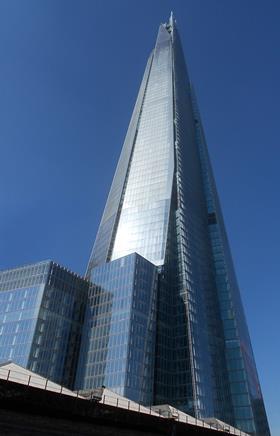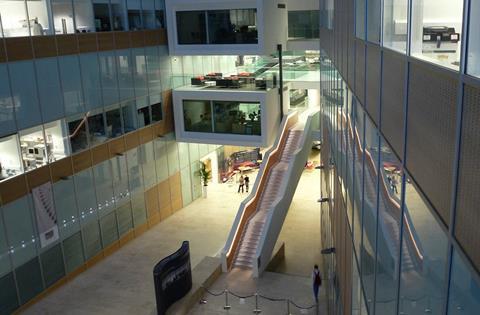This module explains the applications of the open protocol for digital lighting, and its integration into a building-wide open system. It is sponsored by Delmatic
How to take this module
The free continuing professional development distance learning programme from ��ɫ����TV is open to anyone who wants to develop and improve their professional knowledge. These modules can contribute towards annual CPD activity and help you to maintain membership of professional institutions and bodies.
To take this module, read the technical article above and click through to the multiple-choice questionnaire.

Once taken you will receive your results and if you successfully pass you will be automatically issued with a certificate to print for your records. This module will contribute one and a half hours towards your CPD obligations.
DEADLINE: 20 JUNE 2014.
Introduction
Dali stands for Digital Addressable Lighting Interface and is a global standard for digital dimming, as set out in the international standard communication protocol IEC 62386. It was developed by an international consortium of manufacturers of lighting ballasts (current-regulating devices).
This CPD will examine the use and application of Dali technology, how to avoid the need to address Dali ballasts on site, as well as the energy savings that can be made by integrating Dali lighting management systems with other building services using open protocols.
Features of a Dali system
Dali offers a number of key benefits, including:
- Accurate digital dimming from 0-100%
- Lamp and ballast failure detection in real time
- Independence - it is an International Organisation for Standardisation (ISO) protocol, which means it is not owned by any single company. Digital messages can be transmitted and received by any compliant ballast, irrespective of supplier.
When it was first introduced in the late 1990s, Dali was available only for a limited number of fluorescent luminaires. Now, compliant ballasts and drivers are available for all types of fluorescent and LED light sources. It is also used for a wide range of devices including presence detectors, daylight sensors and switches.

Dali installation
Dali can be applied in different ways within different parts of a building to optimise lighting control. Common approaches include:
Dali buswire
Dali is best known for its ability to control individual units along a common buswire. This is one of the key differences from previous dimming technologies, such as analogue 0-10V or digital serial interface (DSI). Up to 64 Dali devices can be connected to a single buswire; projects requiring more than 64 devices use multiple Dali networks, each with up to 64 devices. These networks are connected using other proprietary technologies or open protocols such as Lon.
The Dali buswire approach is widely used with busbar trunking, chilled beams and suspended luminaires, where the ability to control individual ballasts enables flexible lighting strategies.
However, using a Dali buswire approach does present programme and cost implications, as it requires each ballast to be assigned an “address” on site after installation in order for it to be contacted individually. This also means additional work for maintenance staff when individual ballasts are replaced because an address must be assigned to the new ballast.
Dali plug-in
The Dali plug-in approach provides the full flexibility of Dali, including individual control of luminaires as well as lamp and ballast failure monitoring, without the need to assign addresses to the ballasts on site. Plug-in modules incorporate pre-addressed ports and are used extensively in office areas with suspended ceilings where the plug-in connectivity is a major benefit. Dali plug-in also simplifies maintenance, as ballasts can be replaced without the need to assign a replacement address.
Dali broadcast
A Dali broadcast approach enables the control of groups of lights by broadcasting dimming commands to channels of Dali luminaires. The Dali broadcast approach is frequently used in fixed areas such as corridors and cores where control of individual luminaires is not required. As with the Dali plug-in approach, the ballasts do not need to be addressed after installation. Failure detection is in real time and displayed on a channel basis.
Dali zero power
As with any digital device, Dali ballasts consume power in standby mode. In a building with thousands of Dali luminaires, this can represent a large percentage of the overnight power consumption. Dali zero power technology eliminates this by switching off the supply to luminaires when they are dimmed to 0%. Software algorithms analyse occupancy and switch off 230V supplies to areas where all Dali lights are at zero output.
Cabling
Installing Dali solutions is simple, as the mains cable and the Dali communications pair cable can be wired together without segregation. A Dali network requires a nominal 24V DC 250 mA power supply to function. Recommended minimum cable conductor size depends on run length, as follows:
- Less than 100m: 0.5mm2
- 100-150m: 0.75mm2
- 150-300m: 1.5mm2
- Runs of more than 300m are not recommended
Emergency light testing and monitoring
Dali technology offers solutions for the testing and monitoring of all types of emergency lighting in both controlled and non-controlled areas. The original Dali standard has been extended through the introduction of EN 60925 and IEC 62386:202, so that it now combines normal and emergency lighting in a single network and provides the ability to monitor normal and emergency lighting along a common Dali buswire.
Graphical software records and logs data including lamp, ballast and battery performance for maintenance and statutory purposes. Tests are scheduled automatically at intervals and for durations specified within EN 50172, and may be manually initiated from the head-end PC, as well as from routers or programmed keyswitches.
True Dali
Dali’s use extends to a full range of local control devices including presence detectors, multisensors and relays. Some Dali systems on the market use separate protocols and buswires for local control devices. True Dali systems enable Dali switches and sensors to be connected to the same two-core cable that links the Dali luminaires, achieving a substantial reduction in cabling.
Case study: The Shard
The Shard in London is equipped with site-wide Dali lighting controls and uses different strategies in different areas of the building. These include:
Office areas
In Cat A offices, total flexibility is needed for tenant fit-outs. Dali plug-in modules were therefore specified to provide individually addressed outputs without the need for on-site addressing of the ballasts. Rapid plug-and-play installation and tenant familiarity with plug-in modules were major considerations.
Multisensors switch lighting on and off based on occupation, and also dim the lights depending on daylight levels.
Washrooms and toilets
These areas required presence detection and Dali dimming, but luminaires did not need to be individually addressed. Dali broadcast modules were specified to control channels of lighting. One module covers three floors, with the 12 channels assigned to male toilet, female toilet, disabled toilet and lobby lighting on each floor.
Dali presence detectors and emergency monitoring devices connect to the Dali channels, as do Dali relays which control water shut-off valves based on signals from the presence detectors.
Staircases
Presence detectors were required to activate lighting ahead of users as they walk up or down the stairs so that, if a sensor is triggered on one floor, lighting is activated on that landing as well as on the landings two floors above and below.
Dali buswire modules were selected to enable individual addressing of Dali ballasts along a common buswire: these met the operational requirements and suited the vertical electrical wiring installation. The buswire modules also connect to Dali presence detectors on each landing and Dali emergency monitoring devices.

Dali and integrated building services
A Dali lighting management system with daylight and presence detection achieves considerable energy savings. But far more energy can be saved if the operation of heating, ventilation and air-conditioning systems is also connected, with Dali presence detectors and multisensors linking HVAC to occupancy and relating solar shading to daylight levels. Studies by the American Society of Heating, Refrigerating and Air Conditioning Engineers have shown that widening the room temperature band in unoccupied areas by just 2°C achieves an energy saving of almost 10%.
Dali technology is designed for small areas of lighting (up to 64 devices) so applying it across an entire building requires another communication protocol to connect the Dali control modules. As Dali is an ISO open protocol, it makes sense to link using another ISO open protocol rather than a closed, proprietary protocol. There are a number of ISO standard protocols including LonWorks (Lon), KNX and BACnet, which are widely used by building management system (BMS) providers for HVAC products, and solar shading companies for blind and shading controllers.
Integrated Dali case study: ADIA HQ
The Dali lighting management system at the Abu Dhabi Investment Authority HQ in Abu Dhabi forms part of a site-wide integrated system comprising lighting, HVAC and window blinds.
The Dali project was the first application in the Middle East to truly address sustainability, and full interoperability between lighting, air-conditioning and solar shading blinds makes it the most integrated and efficient project in the region.
The Dali system integrates seamlessly with window blind and air-conditioning controls using the Lon international open protocol. Window blind controllers, HVAC controllers and the Dali controllers connect to a common Lon buswire (achieving savings in both cabling and network installation) and share information including occupancy monitored by the system sensors.
Integrated Dali case study: Laboratory of Molecular Biology
The Medical Research Council’s new Laboratory of Molecular Biology (LMB) in Cambridge optimises energy efficiency through an intelligent Dali system that relates HVAC and lighting to occupancy and reduces light intensity when daylight is available.
The Dali system provides individual addressable switching, dimming and monitoring of 14,000 Dali luminaires, as well as testing and monitoring of 3,500 Dali emergency devices.
The system incorporates Dali presence detectors and multisensors and optimises energy efficiency by passing on information regarding occupancy to the building BMS so that heating/cooling as well as lighting is linked to the presence of building users and is only used where required.
The system provides extensive real-time monitoring of the installation including individual lamp failure, ballast failure and emergency monitoring failure of every luminaire in the building including lighting in plant areas and basement link tunnels.

How to take this module
The free continuing professional development distance learning programme from ��ɫ����TV is open to anyone who wants to develop and improve their professional knowledge. These modules can contribute towards annual CPD activity and help you to maintain membership of professional institutions and bodies.
To take this module, read the technical article above and click through to the multiple-choice questionnaire.

Once taken you will receive your results and if you successfully pass you will be automatically issued with a certificate to print for your records. This module will contribute one and a half hours towards your CPD obligations.
DEADLINE: 20 JUNE 2014.
Privacy policy
Information you supply to UBM Information Ltd may be used for publication and also to provide you with information about our products or services in the form of direct marketing by email, telephone, fax or post. Information may also be made available to third parties. UBM Information Ltd may send updates about ��ɫ����TV CPD and other relevant UBM products and services. By providing your email address you consent to being contacted by email by UBM Information Ltd or other third parties. If at any time you no longer wish to receive anything from UBM Information Ltd or to have your data made available to third parties, contact the Data Protection Coordinator, UBM Information Ltd, FREEPOST LON 15637, Tonbridge, TN9 1BR, Freephone 0800 279 0357 or email ubmidpa@ubm.com. View our full privacy policy at






















No comments yet